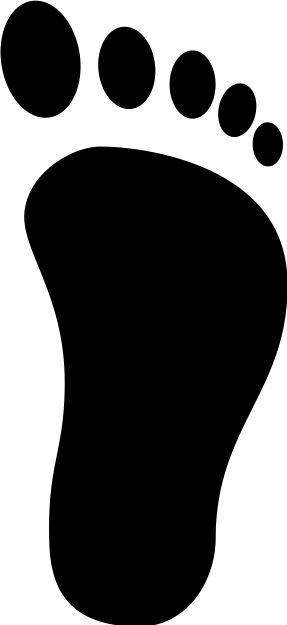What's the best type of running shoe? One that's suited to your individual foot. Below is my guide on how to find suitable workout trainers and sneakers for your running. Part of the beauty of running is its sheer simplicity. You don't need to spend an arm and a leg in order to purchase top-notch gear. Other than decent shoes, and loose-fitting clothing, you really don't need a lot else.
However, don't be fooled into thinking this means you can make do with any old pair of trainers.
More...
Running itself may be simple, but the stress and strains of tens of thousands of foot strikes place special demands on your footwear.
Get it right and you'll enjoy mile after mile of comfort and enjoyment. Get it wrong and you'll be injured before you can say "running shoe"...
Preventing running-related injuries with appropriate shoes
The majority of running-related injuries occur because runners choose the incorrect shoe for their foot type and gait pattern.
Along with knowing your foot type, knowing how much you pronate is key to selecting the best shoe for you.
Once you have that covered, you can see which shoes you need.
Unfortunately, this is not how most of us go about choosing the right running shoe.
When surveyed through some of the major sports stores, 43% of customers said "aesthetics" was their biggest consideration when buying running shoes.
Oddly enough this included serious runners, athletes, active people as well as those just wanting to look good in the latest gear.
Based on these statistics, it's easy to see why there is such a high incidence of running-related injuries.
A 90kg runner doesn't hit the ground with 90kgs of force. It's actually nearer a tonne of force with every single footfall.
Second on customers' consideration lists was brand loyalty.
Sticking to a brand is uncomplicated after all; if you loved one show in the range of a certain brand, why try a competitor?
Or, conversely, you may be put off a brand if you've had a bad experience wearing one of its styles. In which case, why should you go back?
Thankfully, some buyers surveyed rightly took the time to ask retailers for advice on the best shoe for their foot type.
7% said they required a show with a particular ft and certain features that aided their gait pattern.
Mind you, 7% really isn't that many.
Running forces and how the right shoe can help
Before discussing running show technology and how to choose the best pair of shoes, it helps to understand the stresses and strains running places on the body. Then we can appreciate why particular shoe technology has evolved.
Our bodies have evolved over millions of years to cope with the demands of walking and running.
READ ALSO: Running for the Complete Beginner
Albeit on soft ground, such as grassy plans. Not on hard artificial surfaces.
Naturally soft ground provides plenty of protection from the impact of footfall. This is in stark contrast to pavements and roads.
When your foot hits paving stones or concrete, the deceleration from movement to rest is very rapid. This deceleration effectively amplifies the force of gravity as felt by your body during a foot strike.
A 90kg runner doesn't hit the ground with 90kgs of force.
It's actually nearer a tonne of force with every single footfall.
Over a 10-kilometre run, this equates to around 10,000 tonnes of cumulative impact. If unchecked, this shock can wreak havoc with ankle, knee, hip and lower back joints. It can even lead to stress factors.
The main task of any running shoe, therefore, is to provide adequate cushioning and protection against impact shock.
Cushioning, gels and air pockets
However, a heap of cushioning by itself is not enough to keep injuries at bay. That's because, after each foot strike, the foot has to roll forwards and push up again - ready for the next stride.
Although most of this motion is in the forwards/backwards direction, there's also a degree of lateral motion. Part of this motion is due to the normal process of pronation (where the foot rolls inwards as well as forwards).
Overall, this helps to absorb shock, but some (more random) lateral motion results because of uneven surfaces.
The other task of a running shoe, therefore, is to control motion.
That is to say, to provide enough lateral support and stability to stop the foot tilting excessively inwards or outwards during running.
Without this support, there may be excessive twisting, leading to possible injuries in the knee and/or hips.
Furthermore, your shoes also need to allow enough flexibility in the forwards/backwards direction to enable the foot to bend naturally.
While combining cushioning and motion control in a single shoe appears simple enough, it's actually quite difficult.
The more cushioning and shock absorption a shoe offers, the more difficult it becomes to maintain optimum support and stability.
Running shoe technology
Manufacturers use a number of cushioning and motion control technologies in running shoes. Companies will proudly present these in their marketing blurb and adverts:
Shock absorption technology
There are two main types of technology used to absorb shock and increase cushioning. Absorption and reflection.
In absorption, the shoes' soles contain materials such as gels, foams and different types of polymers. These materials absorb as much of the kinetic energy of the foot strike as possible. They dissipate the energy harmlessly into heat.
This means less of the energy from the impact of foot strike travels up the leg in the form of a shockwave. Shoes that use lots of these absorptive materials tend to feel quite soft and squidgy underfoot.
The other method of controlling shock is to use materials that store the energy of the impact. It's then released in a controlled manner.
Examples are air pockets and resilient materials woven into compressive layers.
Although not as soft or comfortable underfoot as absorptive materials, these 'energy return' devices can increase running efficiency.
Some of the energy absorbed during foot strike is returned as forward-motion on the push-off phase of the next stride. Shoes relying heavily on energy return materials tend to feel very springy underfoot.
In reality, of course, all running shoes use a combination of both absorption and energy return materials.
Manufacturers can vary the proportions of each to 'tune' the way a running shoe feels. This can help them match it for its intended use.
Motion control technology
Manufacturers have a number of ways to implement motion control in their shoes.
Virtually all shoes incorporate a heel counter. A stiff, firm cup encased in the upper part of the shoe and which cradles the heel. It thereby limits rearfoot motion.
Another trick is to use different, or dual densities, of shock-absorbing foams and polymers in the mid-sole.
By using a firmer material on the inside of the midsole than on the outside, the shoe can control how the foot moves. This can substantially reduce the amount of pronation that occurs.
This effect can be enhanced by a footbridge (or medial post). This is a firm, relatively incompressible material inserted along the inner side (under the arch) of the shoe.
The correct running shoe for you will be the one that matches your foot type and helps to encourage a neutral running gait
The shape of the sole also affects the way the shoe controls foot movement.
Just as with shock-absorption technology, all running shoes use a combination of methods to try and match the motion control requirements of your feet.
Finding your perfect running shoe match
Hopefully, you can now see that as manufacturers 'tune' different shoes for different runners and running styles, there's no 'best' running shoe out there.
What's great for me won't necessarily work well for you. Or your mum, or your brother or your best mate. At best, you'll find a shoe that meets your own individual needs,
Your particular requirements for a shoe will depend on a number of factors:
Given all of that, there's an even more important consideration - your running style.
Ultimately, your running style (and what shoe you require) depends on your basic foot type
There are 3 basic foot types: flat foot/pronated; high-arched foot (supinated); and neutral/ideal foot.
These three different foot types tend to lead to different running gaits or movement patterns. These gaits differ both in the foot itself and in the subsequent motion of the ankles, legs and hips.
The correct running shoe for you will be the one that matches your foot type and helps to encourage a neutral running gait.
The table below explains these different foot types and what types of shoes and technologies are best suited to each type.
Foot type | Main characteristics | Suitable shoes and technology to look for |
|---|---|---|
Flat-foot / Pronated | Runners with this type of foot have a low arch. This, in turn, tends to lead to excessive pronation. Pronation is a kind of rolling action, where shock from the footstrike is absorbed as the foot rolls inwards. If excessive pronation occurs, larger than normal twisting forces transmit upwards into the legs. These forces can cause problems at the knee joints or hips and lower back. About 60% of the population has this foot type | Look for: |
Neutral / Ideal | The foot strikes on the outside of your heel, then rolls inwards slightly to absorb shock. Runners with this type of foot normally don't have much problem with motion control. For runners of ideal body weight, this foot type is considered the most biomechanically sound. | Look for: |
High-arched / Supinated | Runners with this type of foot generally have rigid, inflexible feet. They have insufficient natural pronation and therefore lack a degree of shock-absorption. Some even suffer from 'supination', which is a rolling outwards motion. This type is more at risk from impact injuries to the ankle and stress fractures. | Look for: |
Knowing which running shoe to choose | Use the wet test to determine your foot type
If you don't already know your foot type, try the 'wet test.'
Dip your feet in water, stand on a dry surface and then look at the imprint. Alternatively, you can look at your footprints on the bathroom floor after taking a shower.
By selecting the closest match to the diagrams below, you'll get an idea of the kind of running action you're likely to have.
What's my foot type? The wet test can give you clues |
|---|
 neutral  flat  high arch |
Your existing shoes can also provide clues as to your foot type.
Find an old, well-worn pair of trainers and plonk them on the floor. Get down level and look end-on, directly from behind the heel. Does the heel counter tilt inwards, or outwards slightly? Or is it vertical?
Now turn them over and examine the sole. In particular, where the sole has worn most of all.
Different foot types tend to show different wear patterns:
Determining foot type from an old pair of shoes | |
|---|---|
Flat-foot / Pronated | Heel counter/cup may tilt inwards. Quite a lot of wear on inner heel and inner forefoot areas of the sole compared to outer areas |
Neutral / Ideal | Heel counter pretty much vertical. A fairly even wear pattern on the sole. |
High arch / Supinated | Heel counter will be vertical or maybe even tilt slightly outwards. A lot of wear on outer heel and outer forefoot areas of sole compared to inner areas. |
When and how to buy running shoes
How often should you replace your running shoes?
This is best measured in kilometres. Repeated pounding eventually compresses the cushioning materials in the midsole. This leads, at the very least, to a loss of cushioning and perhaps even to a gross distortion of the midsole. This can really throw the foot out of its neutral gait.
Either way, you'll have a recipe for injury.
The life expectancy of a running shoe is also linked to your weight and the surface you run on. If you tend to run on hard surfaces like concrete, or you're a heavier runner, replace your shoes every 650km or so. If you run on soft surfaces or are particularly light on your feet, aim to purchase a new pair every 800km or so.
Remember - if you wear your running shoes for activities besides running (e.g. walking), count those miles too.
If you're on a budget and racking up big mileage, bear in mind that shoes with polyurethane midsoles tend to maintain their level of cushioning longer than shoes with EVA midsoles.
Other running shoe buying tips
Achilles tendon problems? Avoid air soles and excessively spongy heels. Avoid shoes with very stiff soles. You want the sole to bend easily where the toes attach to the foot. Also, make sure there's a decent Achilles tendon notch in the heel counter to avoid rubbing.
Stress fractures? Get a flexible shoe with plenty of cushioning. Change your shoe every 600km, or sooner.
Knee problems? Make sure your shoe has plenty of support and stability. If you have flat feet, this is particularly important. Straight-shaped soles may suit you better.
When shopping for new running shoes, trainers and sneakers
If you can, locate a specialist running shop in your area. You'll be able to get expert help and advice from those who run themselves.
Ordering online is only worthwhile if you're absolutely certain that the shoe you're buying is both comfortable and right for your requirements.
Don't forget it needs to be the correct size too!
Browsing online for bargains can be particularly useful if you're replacing a worn-out pair with a new pair of the same make and model.
I'd recommend avoiding the big 'general' high street sports shops unless you're confident you know what you're looking for. Although there are exceptions, the staff may lack the specialist knowledge required to help you make an informed choice.
(Shoe) Size matters
Determining your shoe size is essential to a comfortable fit.
Don't be afraid to try different sizes. I particularly like brands and stores that offer 0.5 increments in sizes.
If shopping online, check the store's delivery and returns worthwhile. If budget allows, considering ordering a pair in a couple of different sizes. Try them all on and send back the ones that don't fit quite right.
The shoe size numbers on boxes are only a guide. Take a size 11 from three different manufacturers and it will almost certainly come in three different sizes.
Remember too that you may have one foot that is bigger than the other. This may or may not be by a significant amount. If this is the case, the shoes should be fitted based on your larger foot.
When fitting, always allow a good finger's width room between the toes and the front of the shoe.
This will help accommodate foot expansion when running and make sure there's adequate width in the shoe at the widest part of the foot. The shoe shouldn't be too tight, but the foot should not slide around either.
If in doubt, err on the slightly larger side.
Unlike boots, running shoes shouldn't need a 'break-in' period and should feel good from the word go. If they don't feel immediately 'right' try another model.
Finally, try and buy shoes at the end of the day, when your foot has reached its full size. Avoid first thing in the morning.
Running shoe jargon buster
Some of the most common terms you're likely to encounter when reading shoe descriptions.
Last shape | This refers to the overall shape of the sole. As a rule of thumb, flat flexible foot types are better suited to straight lasts. Semi-curved or curved lasts suit high-arched, rigid feet better. |
Slip lasting | Shoe construction method which stitches the upper of the shoe that is slipped onto a last. The upper is closed down with stitches down the centre, under the foot before glueing it to the midsole. |
Combination lasting | The use of a fibrous, stabilising board. It gets glued to the heel when the shoe is being constructed. The combination of the slip-lasted forefoot (for flexibility) with the stabilising board in the heel gives the shoe more versatility. |
Heel counter | A stiff, firm cup encases in the upper part of the shoe and which cradles the heel. Basically, it limits rearfoot motion. |
Inner sole (or sockliner) | The removable insert that sits directly below the foot. This is often contoured to accommodate the foot more comfortable and can add cushioning too. |
Outsole | The outer rubber sole that makes contact with the ground. The rubber is chosen to offer a good compromise between grip (soft rubber) and wear (hard rubber). |
Midsole | The thick, compressible section between the insole and outsole. This supplies the bulk of the cushioning and also plays a role in motion control. |
Upper | The material that houses the foot and lacing eyelets. Good uppers combine durability, comfort, breathability and a flexible lacing pattern to accommodate different foot shapes. |
Toe box | The front section of the upper, around the toes. It's generally made from stiffer materials (e.g. suede, leather, plastic, etc.) to add protection to the toes. It will also add general durability to the construction. |
Heel notch | A notch cut in the heel cup to avoid irritating the Achilles tendon. |
Dual density | Usually applied to pronation-controlling midsoles. Higher density materials are used on the inner (medial) side and lower density materials on the outer side of the foot. |
Rigidity or sway bar | A lightweight midfoot support piece. It can help maintain proper foot motion and is often used in lighter shoes. |
Medial post | A dense foam or plastic device (or combination of the two). It gets inserted on the inside edge of the shoe to control pronation. |
